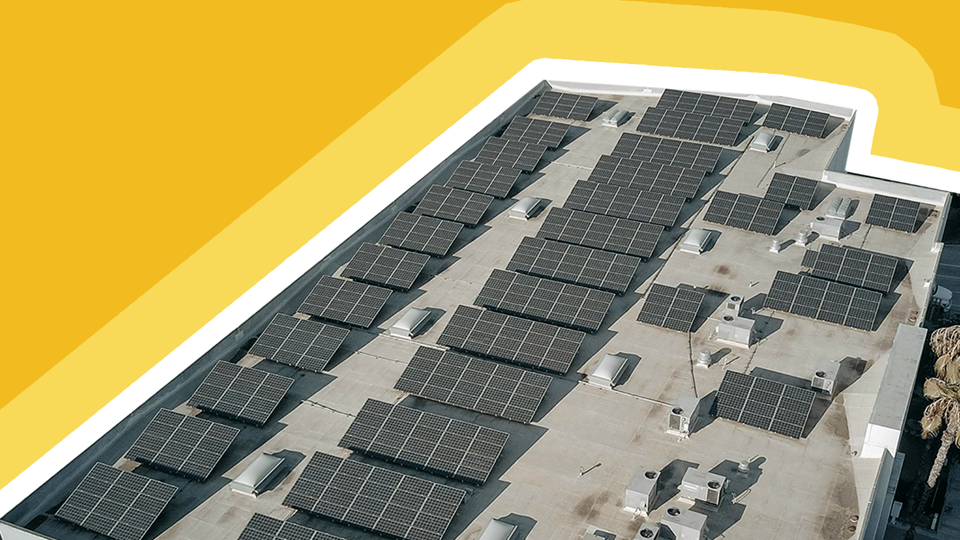- Published On:
Off-Peak Electricity Hours: A Smarter Approach to Energy Consumption & Savings
Are you tired of high energy bills that drain your wallet every month? Do you know about off-peak electricity hours? Off-peak power hours offer a great opportunity to maximize your energy savings by managing your power usage in that duration. By strategically shifting your energy utilization to low-demand hours, you can save big on your energy bills without sacrificing your comfort. In this article, we will highlight how to take advantage of off-peak hours and maximize your energy savings.
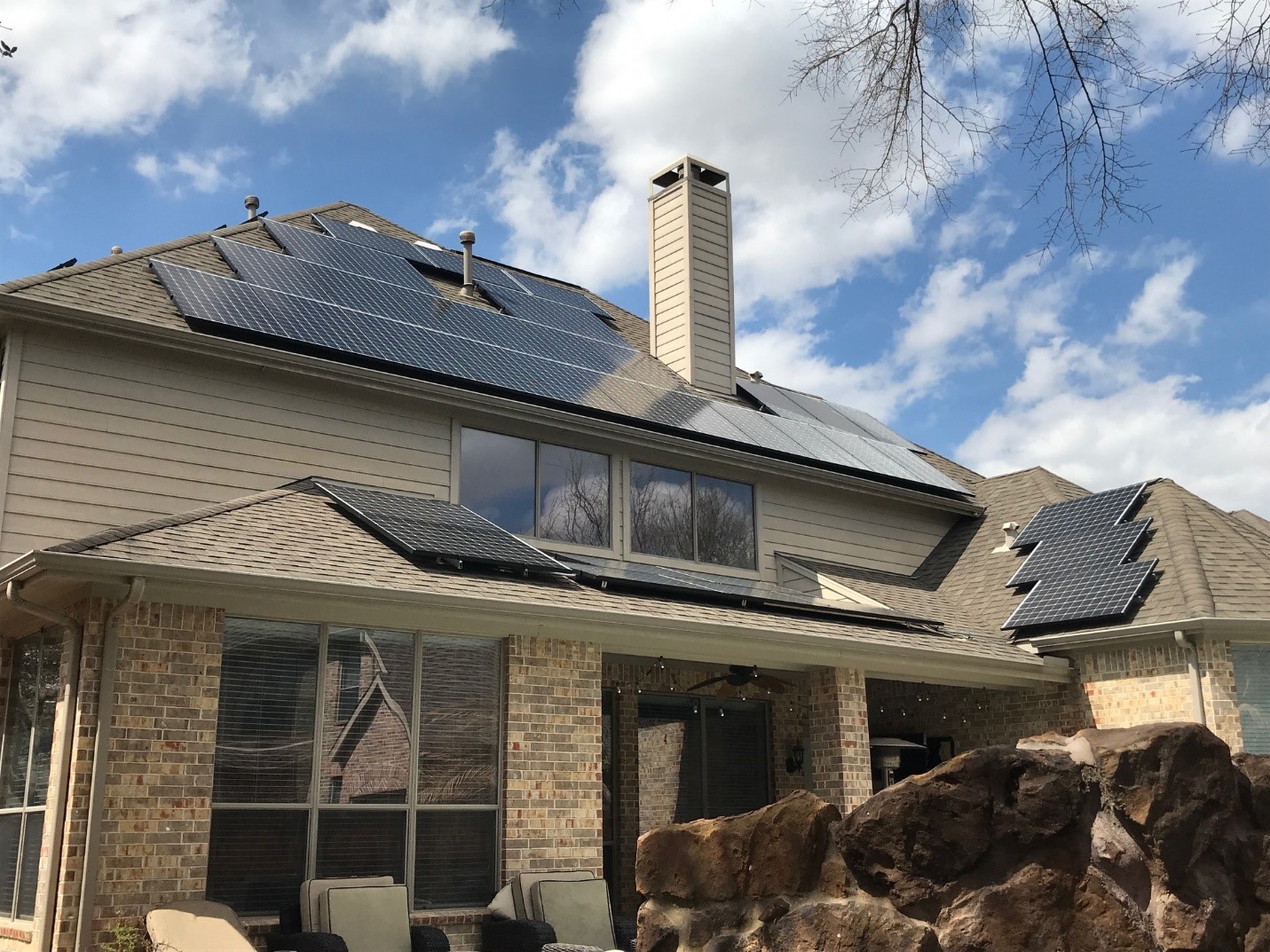
What are off-peak electricity hours?
Off-peak electricity hours refer to the periods of the day when the electricity demand is at its lowest. During these times, the energy grid contains excess capacity, and utility companies offer discounted rates to incentivize customers to consume electricity when it is least in demand. By understanding your local utility’s off-peak electricity hours, you can schedule your energy-intensive activities and appliances to run during these times, resulting in significant savings.
It’s important to note that off-peak electricity hours may vary depending on your location and the specific utility company you are subscribed to. Some utility companies offer off-peak rates during specific hours of the day, while others may have different rates for different days of the week. It’s better to check your utility’s website or contact their customer service to determine the exact off-peak hours applicable to you.
Hours for Off-Peak Electricity:
Finding out off-peak electricity hours is as simple as observing your daily schedule. This is because the consistent timing of work and school hours creates a pattern. Typically falling between 8 a.m. to 5 p.m., these hours represent the hours of lowest electricity demand.
Below are the standard off-peak electricity hours for various time zones. Keep in mind that these hours apply exclusively to weekdays, as energy consumption patterns tend to differ significantly during weekends. The off-peak hours in summer are as follows:
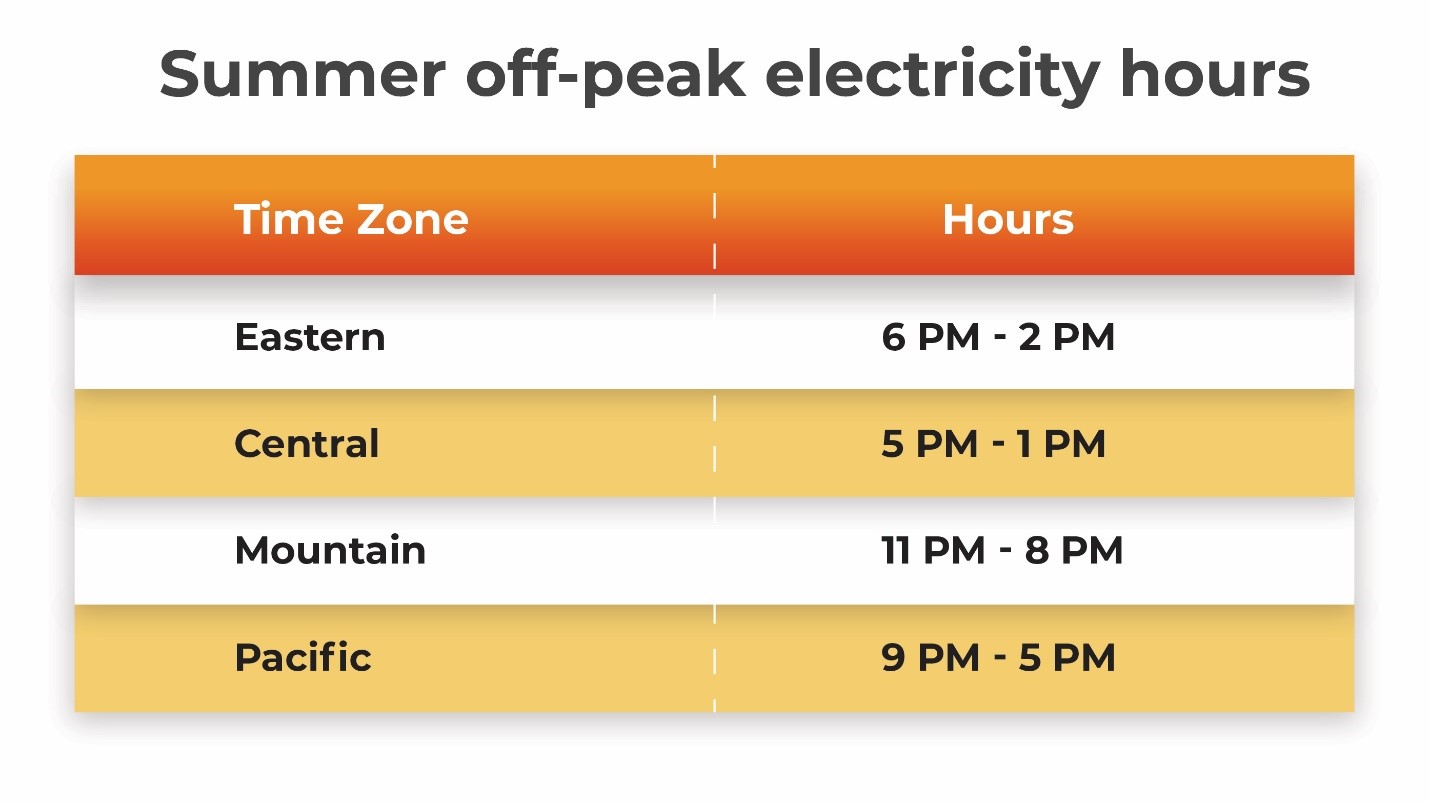
In winter off-peak hours are as follows:
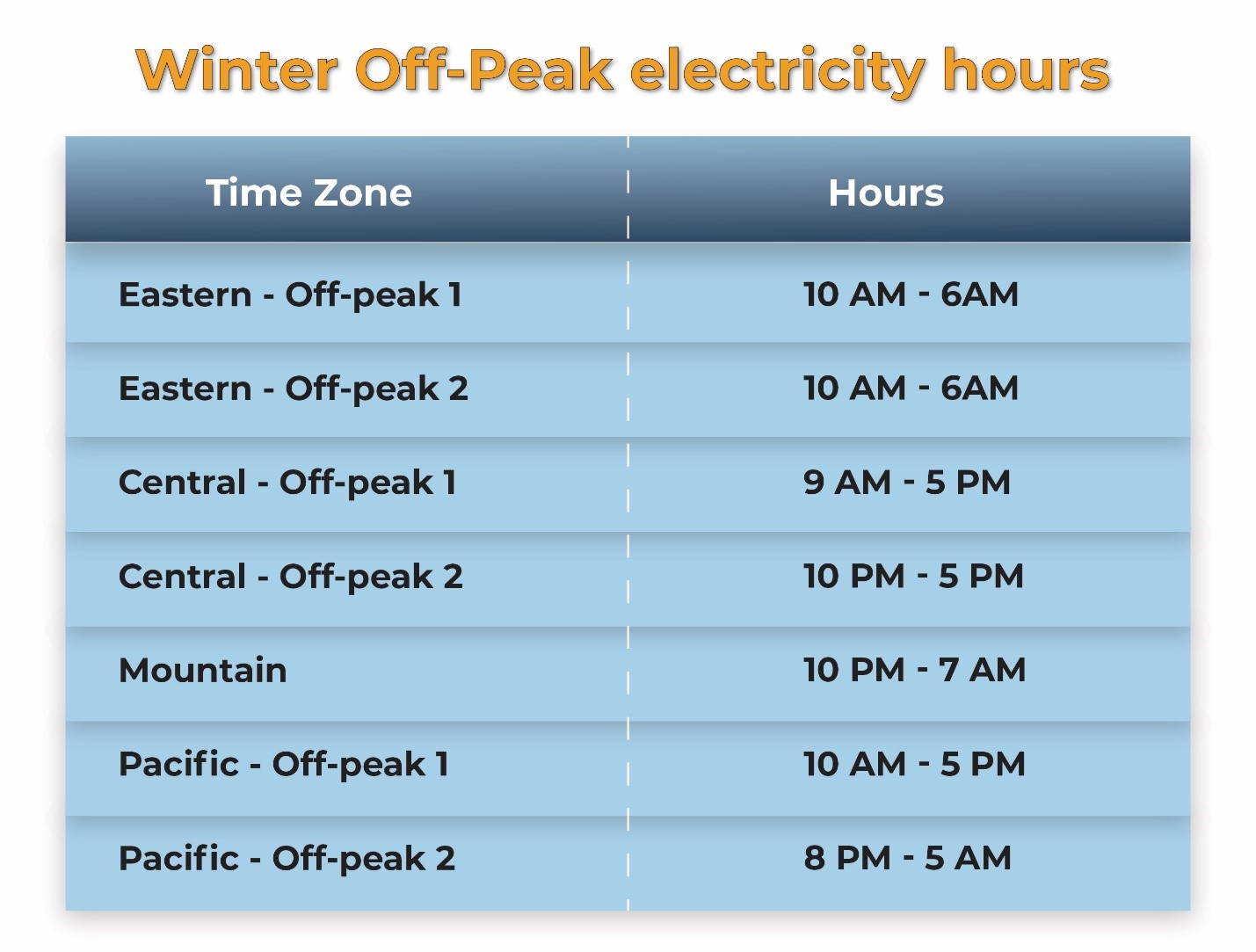
What are peak electricity hours?
Peak electricity hours refer to specific times of the day when energy demand is at its peak. These designated hours can differ based on location and the season of the year.
These durations of peak electricity demand are also associated with elevated electricity costs, leading to ‘peak pricing.’ This means that consumers will incur an extra charge when using electricity during these high-demand timeframes.
Hours for Peak Electricity:
During peak hours, your electricity expenses rise. The price of electricity during these hours fluctuates based on your utility company and the particular rate arrangement you’ve chosen.
The cost of electricity depends on your geographical location and the off-peak hours. On the East Coast, when temperatures peak after 2 p.m., air conditioning tends to be necessary in the summer months. Consequently, the peak hours for this region frequently span from 2 in the afternoon until approximately 6 in the evening.
Conversely, during the winter season, peak hours shift to the early morning as households and businesses use heating systems to ensure comfortable living and working spaces. You might be curious about the cost of energy at night. Generally, data shows that it is cheaper during the night to use electricity, irrespective of region or season. In most instances, you’ll encounter higher electricity rates on weekdays during specific periods.

What are super off-peak electricity hours?
Certain electric utility companies offer time-of-use plans that include a third tier known as “super off-peak electricity hours.” Within these time frames, electricity costs are minimal due to significantly reduced demand.
The primary objective of super off-peak pricing is to encourage a shift in electricity consumption away from the high-demand peak hours. This strategic shift aims to balance out energy usage patterns over the day, contributing to a steadier demand for energy supply.
What is the time of use rates?
Time-of-use plans function based on a system in which customers are billed for electricity based on their usage timing. This method directly connects the price of electricity to its production costs. In the case of households, rates are higher during peak electricity hours due to the utility company facing increased expenses in meeting the elevated demand for power in their operational area.
Why do utility companies require time-of-use rates?
As there are different pricing structure for the customers consuming electricity, there are also different prices for utility companies. It costs utility companies more to generate electricity during peak electricity hours. The electricity consumption is usually highest during those peak hours. To deal with this situation, the utility companies have introduced time of use rates in order to limit the use of electricity during peak hours.
Time of use rates decreases energy consumption during high-demand hours. Moreover, it also allows utility companies to hike the cost of electricity along with the production costs.
How does it work?
Many utility companies divide Time-of-Use (TOU) pricing into three periods, which vary based on the company’s location and the time of the year. These periods are as follows:
- Peak electricity hours: These hours include weekdays from 5:00 p.m. to 8:00 p.m., as well as on weekends. During these times, electricity demand remains highest, and rates are typically the most expensive.
- Mid-peak hours: This is a transition period between peak and off-peak hours. Electricity demand seems to be somewhat lower as compared to peak hours, and rates are moderately priced.
- Off-peak electricity hours: Weekdays before 4:00 p.m. and after 9:00 p.m. are considered as off-peak hours. During these hours, the power demand remains lower and rates are generally the most affordable.
By managing electricity costs based on TOU, utility companies aim to influence how consumers use electricity while also ensuring the stability of the power grid. For instance, when individuals are conscious that running appliances like dishwashers during peak hours can be three times more costly, they tend to schedule these tasks for off-peak hours. This shift in behavior aids utility companies in more efficiently managing the overall demand for power.
Things To Keep in Mind Before Signing Up for Time-Of-Use Electricity Rates
Before enrolling in time-of-use electricity rates, it is essential to look into available rate plans.
Available Rate Plans:
It is important to have information about the available rate plan provided by your electricity provider. These may include TOU plans, tiered plans, solar rate plans, and special rates for EV charging or energy reduction programs.
TOU Rate Dynamics:
TOU plans involve different prices depending on the time and season. Peak and off-peak hours determine your power costs. However, it is important to understand how these fluctuations align with your energy consumption patterns.
Tiered Rate Plans and Compatibility:
Some utility companies integrate tiered rates with TOU plans. Tiered plans charge higher rates for excessive energy use.
Solar Rate Plans:
In case you have solar panels, explore TOU plans that account for energy production and consumption of your system. Net metering can be an important factor in your solar rate plans. In net metering, excess energy generated by your solar panels is sent back to the electricity grid in exchange for bill credit. So, it can alter your solar rate plans.
Special programs:
Check if your utility company offers special programs, such as discounted rates for off-peak EV charging or energy-saving initiatives. These can be integrated into existing TOU plans.
For the best plan, assess your utility company’s website for plan details. Consider factors like solar panels, EV charging, and battery usage, as these impact your energy needs.
Benefits of Using Off-Peak Electricity Hours:
Using off-peak electricity hours offer several benefits beyond just savings. By shifting your energy usage to off-peak hours, you will help to balance the demand rate of the energy grid. This, in turn, reduces the strain on the grid during peak times, leading to a more stable and reliable electricity supply for everyone. Additionally, by using electricity when it is least in demand, you will contribute to a more sustainable energy system, as the need for additional power generation capacity is reduced.
Off-peak electricity hours can also be advantageous for those with electric vehicles (EVs). Charging your EV during off-peak hours can result in savings over time. Many utility companies offer special EV charging rates during off-peak hours. Therefore, making it even more cost-effective to own and operate an electric vehicle.
Off-Peak Electricity Rates and Pricing:
One benefit of utilizing off-peak electricity hours lies in the considerably reduced rates provided by utility companies during these time periods. Off-peak rates can be as much as 50% lower than the rates during peak times. These reduced rates can lead to substantial savings on your energy bill especially if you have high energy consumption or if you can shift the usage of your energy-intensive appliances to off-peak hours.
It’s important to understand that off-peak rates may not be available for all types of electricity usage. Some utility companies may only offer off-peak rates for specific appliances or activities, while others may have more flexible off-peak pricing for all electricity usage. Make sure to review your utility’s pricing structure and any associated terms and conditions to fully understand how off-peak rates apply to your energy consumption.
How to Determine Your Off-Peak Electricity Hours?
To determine your off-peak electricity hours, you can start by checking your utility company’s website or contacting their customer service. Most of the utility companies provide information about their off-peak hours and rates on their websites. You can also inquire about any specific programs or incentives they offer for off-peak electricity usage.
In some cases, utility companies may provide tools and online calculators that allow you to input your location and receive personalized information about your off-peak hours.
What is the cost difference between peak vs. Off-peak electricity hours?
Many people are curious about the disparity in pricing between peak and off-peak hours for various services. However, the truth is that these prices can differ based on different factors like utility companies and seasons.
Let’s take a look at an illustration from PG&E, a Californian electric utility company, showcasing two of their Time of Use rate options.
Plan 1: E-TOU-C
During the summer months:
- Off-peak electricity costs: 33-42 cents per kilowatt-hour (kWh)
- Peak electricity costs: 40-49 cents per kWh
During the winter months:
- Off-peak electricity costs: 28-37 cents per kWh
- Peak electricity costs: 30-39 cents per kWh
Plan 2: E-TOU-D
During the summer months:
- Off-peak electricity costs: 34 cents per kWh
- Peak electricity costs: 47 cents per kWh
During the winter months:
- Off-peak electricity costs: 34 cents per kWh
- Peak electricity costs: 38 cents per kWh
In these Time of Use rate plans, it’s evident that there’s a noticeable gap between off-peak and peak rates. During the summer (ranging from 7 to 13 cents per kWh), whereas this gap is relatively narrower during the winter (2 to 4 cents per kWh).

How to save using time of rate use?
Strategies for Maximizing Savings with Time of Use Rates are as follows:
1.Optimize Electricity Usage during Off-Peak Hours:
If you’re enrolled in a Time of Use (TOU) rate plan, it is a smart to adjust your energy consumption to align with off-peak periods. This tactic can yield both cost and energy efficiency gains. By scheduling power-intensive tasks such as running the dishwasher, using the air conditioner, or charging your electric vehicle during times when electricity costs are lowest, you can significantly reduce your overall electric expenses.
2. Incorporate Home Battery Solutions:
Another effective method to capitalize on Time of Use rates is by integrating a home battery solution. This involves charging your home battery during off-peak times and utilizing the stored energy during peak demand hours. This practice enables you to sidestep the elevated energy costs associated with peak periods. Additionally, adopting a home battery solution can grant you protection against power outages and disruptions.
3. Install Solar Panels with Battery Storage:
The ultimate strategy for mitigating the impact of Time of Use rates is installing a solar power system with battery storage. With a well-designed setup, your solar panels generate surplus energy throughout the day, which is stored in a battery. During the high-demand peak hours in the evening, your energy needs are met by drawing from the stored battery power. This negates the necessity to purchase costly electricity during peak times from your utility provider. As a result, this approach can lead to substantial savings.
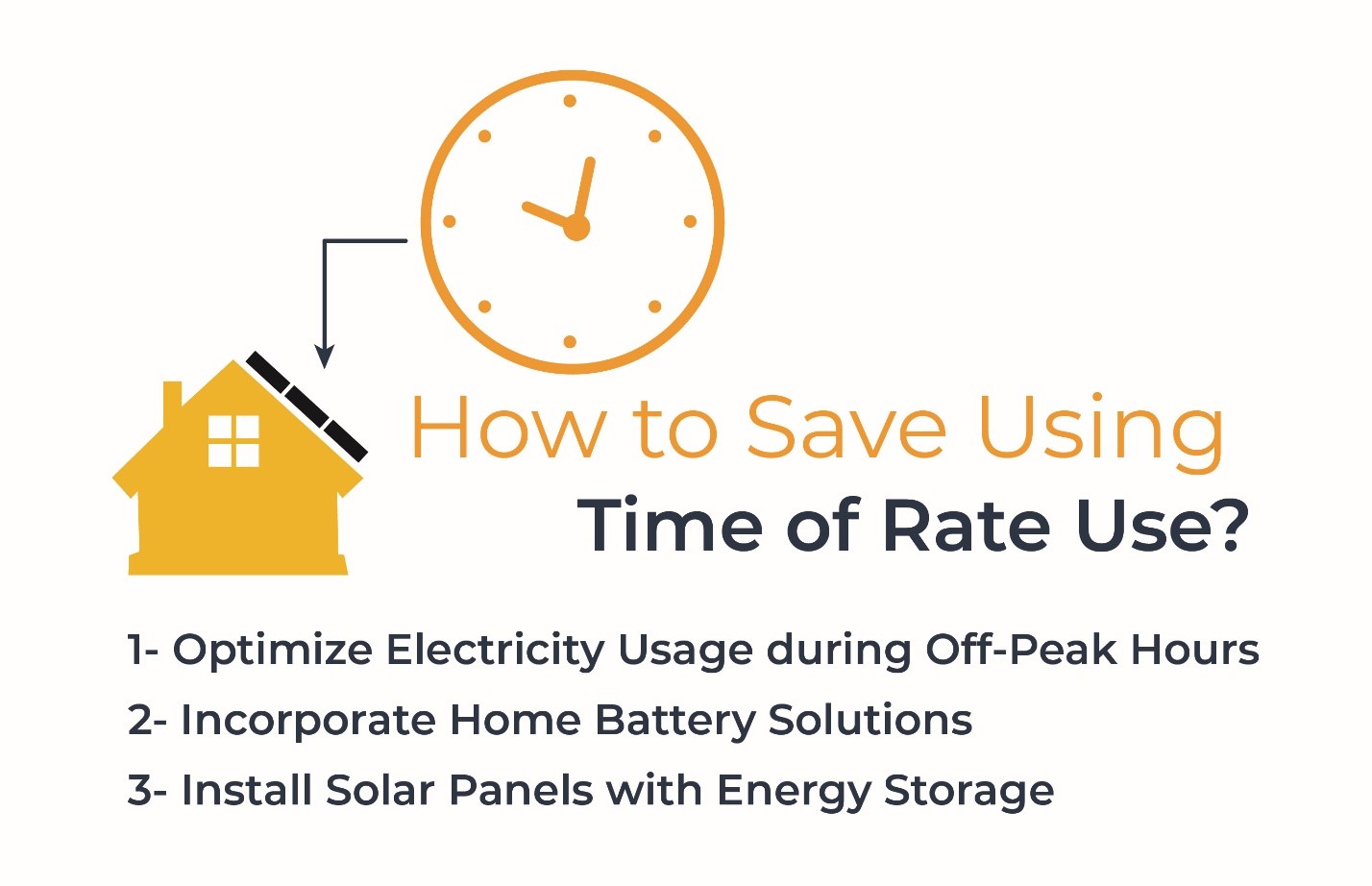
Tips for Optimizing Your Energy Usage During Off-Peak Electricity Hours:
Maximizing your energy savings during off-peak hours requires a strategic approach to your energy usage. Here are some practical tips to help you optimize your energy consumption during these times:
1. Schedule Your Chores:
Plan your energy-intensive activities, such as laundry, dishwashing, and vacuuming, to coincide with off-peak hours. By running these appliances during low-demand hours, you can take advantage of the discounted rates and reduce your overall energy costs.
2. Invest in Energy-Efficient Appliances:
Energy-efficient appliances not only save you money in the long run but also consume less energy during operation. When shopping for new appliances, look for models with high energy efficiency ratings, such as ENERGY STAR-certified products. These appliances are designed to minimize energy consumption and can further enhance your savings during off-peak hours.
3.Use Smart Plugs and Timers:
Smart plugs and timers allow you to automate and control the operation of your appliances. By using these devices, you can schedule your appliances to turn on and off during off-peak hours automatically. This ensures that your appliances are running when electricity rates are at their lowest. Therefore, maximizing your savings without requiring constant monitoring.
4. Adjust your Thermostat:
If you have a programmable thermostat, take advantage of its capabilities to adjust the temperature settings during off-peak hours. By slightly raising or lowering the temperature during these times, you can reduce the load on your HVAC system and save on energy costs.
5. Unplug Unnecessary Electronics:
Many electronic devices consume energy even when they are not in use. Unplugging devices that are not actively being used can help reduce your overall energy consumption during off-peak hours. Consider using power strips to easily turn off multiple devices at once.
By implementing these tips, you can make the most of off-peak electricity hours and see a significant reduction in your energy bills.
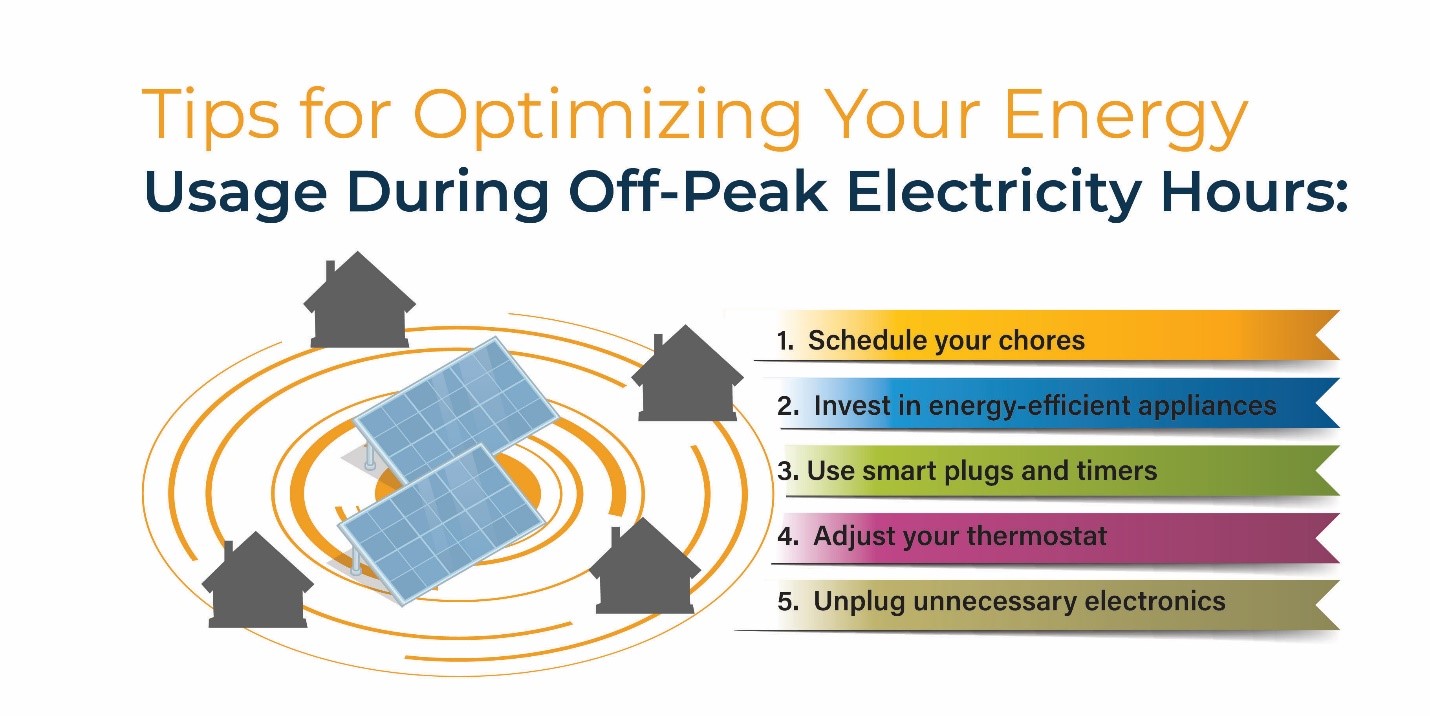
Conclusion:
As energy prices continue to rise, the importance of off-peak electricity usage cannot be overstated. By using off-peak hours, the homeowners have the opportunity to make a significant impact on their energy bills.
So, what are you waiting for? Start exploring your utility company’s off-peak hours and take advantage of the power of off-peak electricity to save big on your energy bill. With the right strategies, appliances, and technologies in place, you can unlock while reducing your environmental footprint. Let’s embark on this energy-saving journey together and watch your energy bills shrink.
Get a FREE Quote for your solar savings if you haven’t gone solar yet with our solar calculator!
Related Articles:
Commercial solar installation is a good option for you to take control of your electricity expenses and decrease your business operating costs.
As the holiday season draws near, many of us ponder a common question: ‘How can I make my festivities more sustainable and eco-friendly?’
Choosing a solar panel system for your home, you’ll typically encounter two main options: off-grid and on-grid (also known as grid-tied) solar systems.

